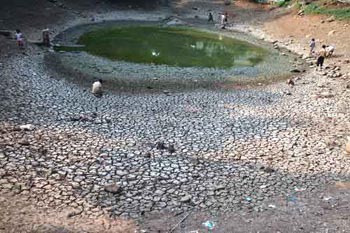| Tools: Save | Print | " target="_blank" class="style1">E-mail | Most Read |
| Severe Drought Sounds Alarm for Water Supply |
| Adjust font size: |
|
Water has hit the headlines amid the sweltering summer heat in southwest China's Chongqing Municipality and Sichuan Province. The worst drought in 50 years left 7.5 million people in Chongqing and 3.1 million people in Sichuan in great thirst. The water depth in the Chongqing section of the Yangtze River, China's longest, hit 3.5 meters (11.5 feet), its lowest in 100 years. About 2.5 million hectares, or 6.18 million acres, of crops were affected. The drought is just a small part of a much-larger problem. In rural areas, the situation is grimmer. More than 300 million people in rural areas are short of clean drinking water and pollution is so severe that the Ministry of Water Resources estimates 40 percent of water in the country's 1,300 or so major rivers is fit only for industrial or agricultural use. The Ministry's 2003 report revealed that the water condition in 70 percent of cities along the Yellow River failed to meet the healthy standard while only two lakes out of 11 in the Yangtze River drainage basin meet water quality standards. In November 2005, a nitrobenzene spill caused by an explosion at a PetroChina refinery in northeastern Jilin Province forced authorities in Harbin, capital of the neighboring Heilongjiang Province, to temporarily cut water supplies to more than 3 million local people. The incident prompted the resignation of China's environmental chief. Meanwhile, as new industrial developments continue to mushroom, demand for water is constantly generated. Factories and urban residents used 34 percent of the nation's water in 2004, up from 25 percent in 1998, according to the Ministry of Water Resources. Consequently, that has hurt grain production, which fell 8.4 percent to 469.4 million tons during the same period, according to the National Bureau of Statistics. "The farmers now face strong competition for water from cities and industry," said Prof. He Shaoling. Across the whole of the North China Plain, where half of China's wheat is grown, 3.6 million wells have been sunk, mostly for irrigation. "The aquifer below is being steadily drained and the water table is 90 meters below the surface and dropping by three to six meters a year," she said, adding that cities have dumped untreated pollutants and waste into the water, making crops wither and the water unusable. "This will result in the reduction in the quality of life of agricultural peasants as crop sizes decrease in line with water availability," she said. "Also, it will undermine the food security of China. If current agricultural yields and population increases continue at present rates of expansion, China may be forced to go to international markets to import staples," she said.
To address China's water shortage and help alleviate drought in the north, the government is spending almost 500 billion yuan (US$62.5 billion) on a diversion scheme to ship the water north. China will build a canal north from the Three Gorges Dam that ultimately will tunnel under the Yellow River to bring some 38-48 billion cubic meters of water to the dry Yellow, Huaihe, and Haihe rivers. "The south-to-north water diversion project will alleviate shortages in China's northern plain, but it won't come close to solving them," said Ma Jun. "We should give priority to conservation because there is now inefficient use of water in agriculture, in the cities, in the urban and industrial uses along the river." China has been a production marvel when it comes to labor costs, but not for water costs. To produce a unit of GDP, China uses approximately six times more water than the Republic of Korea and ten times more than Japan, according to Zhai Haohui, vice minister of water resources. "What China needs most is a dependable and safe internal water supply and a clean environment to act as a stable platform for sustainable economic growth," he said. So far the government has adopted a multi-faceted strategy to the water issue, he said. Water conservation and recycling programs have been introduced and the water price in major cities including Beijing raised as part of an attempt to stem demand. In addition, steps are being taken to curb rapid deforestation and soil erosion across the country. More innovative forms of water creation, including artificially seeding clouds with dry ice, are introduced, and hydropower, which creates large evaporating reservoirs, is increasingly being replaced with wind power. "A better management of water resources is also required to reduce the number of regional fights over water from the Yellow River," Ma Jun said. "Local officials should be judged not just by how fast their local economies grow, but also by how well they protect the environment." "Water is the lifeline of a country's economy and a regional economy. Economic growth cannot be allowed to come at a steep environmental cost. It is time for the government to cope with the realities of declining water stocks and their implications for the whole society," he said. (Xinhua News Agency August 20, 2006)
|
| Tools: Save | Print | " target="_blank" class="style1">E-mail | Most Read |
 |
| Related Stories |

